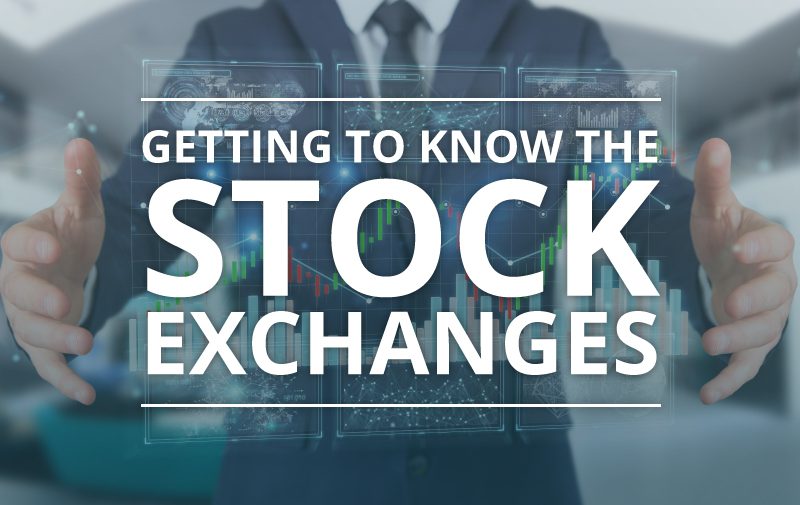What are Stock Exchanges, and What Do They Consist Of?
Historically, the places where sellers and buyers of whatever have gathered have been called markets. The stock market is where companies sell stocks that are offered to investors. In turn, the stock exchange is a platform for concluding financial deals.
Besides stocks, currencies, precious metals, options, futures, and other actives may be traded at a stock exchange.
The stock exchange monitors that all parties comply with their obligations and that transactions are carried out quickly and reliably. Only trusted companies are allowed to trade – you won’t find any blatant fraudsters there. And because there are many buyers and sellers on the exchange, transactions are made at a fair market price.
Stock exchanges have indexes – they show changes in the value of all bonds or specific sectors presented on the exchange.
The Stock Exchange Participants
The issuers are companies, the government, or individual regions that issue shares to raise funding.
The investors are individuals or legal entities willing to buy or speculate on the stock exchange objects.
Stock exchange specialists ensure the liquidity of stock issuances and transactions with non-standard lots.
Commission brokers execute customer orders from brokerage firms.
Stock brokers work with any broker firm.
Stock traders work exclusively for themselves and with their finances.
Regulators monitor the work of all professional participants of the stock market: brokers, administrators, registrators, depositories, and stock exchanges.
The Difference Between the Stock Exchange and the Stock Market
Although the stock exchange and the stock market are concepts that rotate in the same conceptual space, they are not identical.
The stock market is a part of the financial space in which stocks are traded. The stock exchange, in turn, is a platform for investment and speculation with these securities. In simple words, a market is a place where stocks are sold and bought, while an exchange is an instrument of purchase, sale, and interaction of stock market participants.
How the Stock Exchange Works
The stock exchange takes on the organization and control functions: trading takes place according to the rules, prices are transparent, and transactions are fair.
The issuer releases bonds and the investor can buy or sell them. But one cannot buy them directly from the issuer.
To make deals, an investor needs to open a stockbroker’s account. It is a particular account through which one can buy and sell securities and see the entire history of transactions. Transactions are always carried out with the participation of traders or brokers.
How Stock Market Prices are Formed
The value of assets on a stock exchange is formed by the flow of those willing to buy each share and supply availability. The seller sets the bid price, and the buyer sets the asking price. Trading on the stock exchange reflects the actual cost if there is a large volume of transactions.
The exchange does not set the rate of the securities but fixes all transactions – because of this, prices for the same stocks may vary slightly at different exchanges. The market price at each stock exchange is formed when the prices of the buyer and the seller meet.
Artificial Intelligence in the Stock Market
Most of the world’s stock exchanges use computers that make decisions based on algorithms and adjust strategies based on new data. Algorithmic trading is moving toward high-frequency trading, in which stocks are bought and sold. The algorithm quickly detects and exploits divergence, and trading volume is still growing.
Artificial intelligence endlessly processes vast amounts of data, including books, tweets, news, financial indicators, and even entertainment television programs. It is how it learns to understand global trends and constantly improves its predictions about financial markets.
Machine learning for algorithmic trading eliminates irrational feelings such as fear and greed.
In practice, AI is presented as AI software solutions and apps that act as robotic advisors, which apply AI algorithms to make investment decisions based on technical analysis predicting stock price fluctuations.
Stock Exchanges Types
Auction Exchanges
directly bring buyers and sellers together on a stock exchange, where sellers name the minimum price they are willing to pay for an asset, and buyers raise prices to compete for the right to buy it.
Digital Exchanges
are platforms on which one digital currency is traded and exchanged for another world currency, including dollars, euros, and yuan.
Electronic Communication Networks (ECNs)
allow traders to send orders for buying or selling stocks without market makers’ participation, i.e., directly connecting buyers and sellers of stocks.
Electronic Exchanges
allow the execution of various transactions with financial instruments and assets via a global Internet platform. All transactions and operations occur remotely at the electronic exchange, and the trader does not have to be in the stock exchange office.
Over-the-Counter (OTC)
is an alternative to a traditional stock exchange that allows individuals with significant capital to trade stocks and other assets directly. However, it does entail certain risks.
Over-the-Counter Bulletin Board (OTCBB) and Pink Sheets
NASD electronic bulletin board, which belongs to the so-called unorganized over-the-counter markets. OTCBB is a similar OTC market at Pink Sheets. But Pink Sheets is a private company, and NASDAQ owns OTCBB.
5 World’s Biggest Stock Exchanges
As of 2022, the most prominent players in the global stock market are:
NYSE, or the New York Stock Exchange, with more than $25.3 trillion in capitalization and more than 4,000 companies trading. To be listed on the NYSE, an issuer must earn $2.7 million yearly before taxes and other expenses are deducted. This exchange calculates the Dow Jones Index, the NYSE Composite, and the NYSE ARCA Tech 100 Index.
NASDAQ or the National Association of Securities Dealers Automated Quotation Service with more than $22 trillion in stock capitalization and 4,000 issuers. This U.S. exchange more often deals with stocks of high-tech companies. The NASDAQ Composite, NASDAQ-100, and NASDAQ Biotechnology indices are calculated here.
SSE, or Shanghai Stock Exchange, has a capitalization of over $7.6 trillion and more than 2,000 issuers. It trades two types of shares: Yuan-denominated and Dollar-denominated. In addition, the exchange calculates indexes SSE Composite and SSE 50.
HKSE, or Hong Kong Stock Exchange, with a capitalization of $6.8 trillion and 1,400 issuers. Companies on this exchange can be tracked with the Hang Seng Index.
TSE, or Tokyo Stock Exchange, is capitalized to $6.7 trillion and has more than 2,500 companies trading there. The Tokyo Stock Exchange sells not only Asian assets but also global ones. Therefore, you must keep an eye on the NIKKEI 225 and TOPIX indices.
We mentioned a lot about capitalization because it is the primary indicator of the stock exchange. It reflects the sum of all assets involved in the stock market.
About the author:
Janet Polson is a graduate of George Washington University in International business. She is an unspoken expert in the study of science and philosophy. Janet is also a blogger, author of tech articles and she works as business analyst at Computools.

